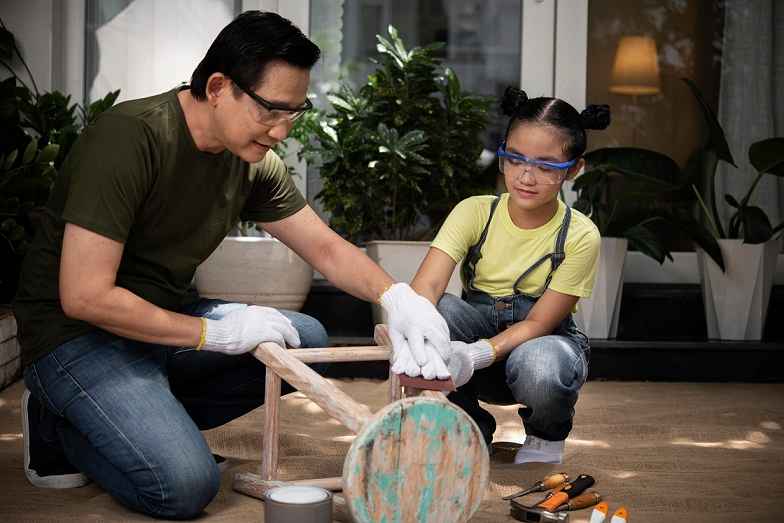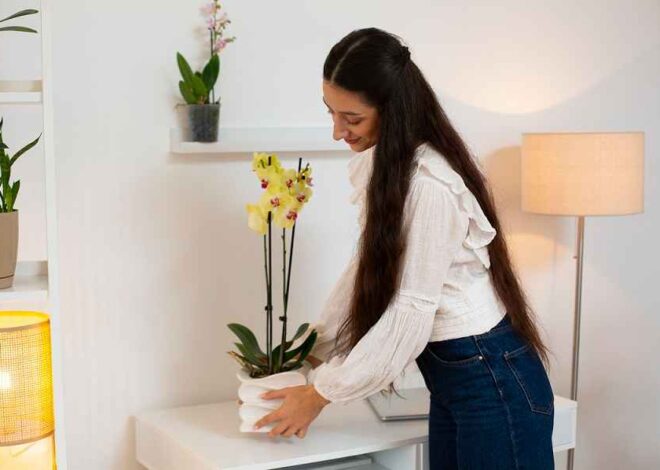
10 Essential Home Maintenance Tasks for a Safer Living Environment
Home is where the heart is, but it’s also where countless hidden hazards can lurk. From squeaky doors to leaky faucets, our beloved abodes often need a little TLC to ensure they remain safe and welcoming spaces. Maintaining your home goes beyond aesthetics; it’s about creating a sanctuary that protects you and your family from unexpected mishaps.
Whether you’re a seasoned homeowner or just starting out, these simple yet effective tips will help you take charge of your space—keeping peace of mind at the forefront while enhancing comfort and security in every room. Let’s dive in!
Introduction: Highlighting the importance of regular home maintenance for safety and the overall well-being of a household
Your home is more than just a roof over your head; it’s your sanctuary, your comfort zone, and often the largest investment you’ll ever make. But how safe is that sanctuary? Regular home maintenance plays a crucial role in ensuring not only the safety of its occupants but also the overall well-being of your household. When tasks are overlooked or neglected, they can lead to significant hazards—both physical and financial. By taking proactive steps today, you can protect your family and enhance the longevity of your property for years to come. Let’s dive into some essential maintenance tasks that keep your living environment safe and sound!
Understanding the Risks: Explaining potential hazards that may arise from neglecting home maintenance tasks
Neglecting home maintenance can lead to serious risks that endanger both your property and the safety of its occupants. Small issues, like a leaky roof or faulty wiring, can escalate into costly repairs if left unattended.
Water damage is one significant hazard. It not only compromises structural integrity but encourages mold growth, which poses health risks. Similarly, outdated electrical systems can trigger fires if they aren’t regularly inspected.
Inadequate ventilation in HVAC systems may result in poor air quality and respiratory problems for family members. Even pests might find their way inside through unnoticed cracks and gaps, leading to infestations that are hard to eradicate.
Ignoring these maintenance tasks puts more than just your house at risk; it jeopardizes the comfort and well-being of everyone living within its walls. Taking proactive steps ensures a safer environment for you and your loved ones.
Essential Maintenance Tasks: Providing a list of 10 crucial home maintenance tasks for a safer living environment, including:
Regular home maintenance is key to ensuring a safe living environment. Here are ten essential tasks you shouldn’t overlook.
First, check your smoke and carbon monoxide detectors monthly. These devices save lives by alerting you to danger before it’s too late.
Next, inspect electrical systems for frayed wires or overloaded outlets. This simple step can prevent fires and ensure your appliances function properly.
Maintaining HVAC systems is crucial for air quality and comfort. Schedule regular servicing to keep them running efficiently.
Don’t forget about gutters and downspouts—clean them out every season to prevent water damage around your foundation.
Sealing windows and doors helps control your home’s temperature while keeping pests at bay. Look for gaps that need attention.
Examine the roof and siding regularly for any signs of wear or damage; early detection can save significant repair costs later on.
Testing plumbing systems ensures no leaks go unnoticed, which could lead to mold growth over time.
Keeping outdoor spaces tidy not only enhances curb appeal but also reduces hazards like slips or falls in the yard.
Lastly, monitor the foundation and basement areas closely for signs of water intrusion; a small issue today could become a bigger nightmare tomorrow.
You may also read (importance home safety for seniors)
-
Checking Smoke and Carbon Monoxide Detectors
Smoke and carbon monoxide detectors are crucial for keeping your home safe from potential fires and gas leaks. These devices work by alerting you with a loud alarm when smoke or carbon monoxide levels reach a dangerous level, giving you enough time to evacuate and call for help.
To ensure the effectiveness of these life-saving devices, it is important to regularly check and maintain them. Here are some essential home maintenance tasks for checking your smoke and carbon monoxide detectors:
- Test the alarms: Most modern smoke and carbon monoxide detectors come with a test button that allows you to check if they are working properly. Press the test button on each detector to make sure the alarm goes off loud and clear. If not, replace the batteries or the entire unit if necessary.
- Clean the detectors: Dust, dirt, and other debris can accumulate inside your detectors over time, making them less sensitive to detecting smoke or gas. Use a soft cloth or brush to gently clean the exterior of your detectors every few months.
- Replace old batteries: The batteries in your smoke and carbon monoxide detectors should be replaced at least once a year, even if they seem to be functioning fine. It’s best to mark it on your calendar so you don’t forget this important task.
- Check expiration dates: Most manufacturers recommend replacing smoke alarms every 10 years and carbon monoxide alarms every 5-7 years, depending on their type and model. Check the expiration date on each device and replace them accordingly.
- Keep an eye on warning lights: Some newer models of smoke alarms have warning lights that indicate low battery life or malfunctioning sensors. Make sure these lights are functioning properly by pressing the test button regularly.
6 .Placement matters: For maximum protection, install smoke alarms in every bedroom, hallway leading to bedrooms, as well as on each level of your home. Carbon monoxide detectors should be placed near sources of carbon monoxide, such as gas appliances and fireplaces.
Regularly checking and maintaining your smoke and carbon monoxide detectors is crucial for the safety of your family and home. Don’t wait until it’s too late to realize that these life-saving devices are not functioning properly. Make it a habit to perform these maintenance tasks at least twice a year, or more frequently if recommended by the manufacturer. Remember, prevention is always better than cure when it comes to protecting your loved ones from potential dangers in your home.
-
Inspecting Electrical Systems
Ensuring the safety and functionality of your home’s electrical systems is crucial for maintaining a safe living environment. Faulty or outdated electrical systems can not only cause inconvenience but also pose serious risks such as electrical fires or electrocution. Therefore, it is important to conduct regular inspections of your home’s electrical systems to identify any potential hazards and address them promptly.
The first step in inspecting your home’s electrical systems is to locate the main panel or circuit breaker box. This is where all the circuits in your house are connected and controlled. Check for any signs of wear and tear, such as frayed wires or burnt smells, which could indicate a potential problem. If you notice any damage, it is recommended to call a licensed electrician to resolve the issue.
Next, check all outlets throughout your house for loose-fitting plugs or signs of scorch marks around the edges. These can be indications of overloaded circuits or faulty wiring and should be addressed immediately. In addition, make sure that none of the outlets are warm to touch as this could also be a sign of an underlying problem.
Another essential aspect of inspecting electrical systems is checking for proper grounding. Grounding ensures that excess electricity has somewhere safe to go if there is a surge or short-circuit in the system, protecting both you and your appliances from potential harm. To test grounding, use a plug-in circuit tester on each outlet in your home – if any show improper grounding, it should be fixed by a professional electrician.
It’s also important to regularly check light fixtures for any loose connections or exposed wires that could potentially cause sparks or fires. Replace any bulbs that are flickering frequently as this may indicate an issue with the fixture itself rather than just a burnt-out bulb.
In addition to these visual checks, homeowners should also schedule regular professional inspections every few years or when purchasing an older property. Electricians have the expertise and tools to identify potential hazards that may not be visible to an untrained eye, ensuring your home’s electrical system is up to code and safe for use.
Inspecting your home’s electrical systems should be a top priority in maintaining a safe living environment. By following these steps and being proactive in identifying and addressing any issues, you can ensure the safety of your home and loved ones. Remember to always seek professional help if you are unsure or uncomfortable handling any electrical tasks yourself.
-
Maintaining HVAC Systems
Maintaining your HVAC (Heating, Ventilation, and Air Conditioning) system is crucial for creating a safe and comfortable living environment in your home. Not only does it ensure that you have a properly functioning heating and cooling system, but it also plays a significant role in maintaining good air quality. Regular maintenance can prevent potential health hazards such as mold growth, carbon monoxide leaks, and poor indoor air quality.
-
Essential Tasks for Maintaining HVAC Systems
a. Changing Air Filters: The most basic yet essential task for maintaining your HVAC system is regularly changing the air filters. These filters are responsible for removing dust, allergens, and other pollutants from the air circulating in your home. Neglecting to change them can cause clogs, reducing the efficiency of your system and potentially leading to costly repairs.
b. Cleaning Ducts and Vents: Over time, dust, dirt, pet hair, and other debris can accumulate in ducts and vents of your HVAC system. This buildup not only affects the airflow but also decreases indoor air quality. Regularly cleaning these areas can improve overall system performance and promote better air circulation throughout your home.
c. Checking Condenser Unit: The condenser unit is responsible for transferring heat from inside your home to outside during summertime while also providing warm air during winter months. It is essential to check this unit periodically to make sure it is clean from any debris or vegetation that may obstruct its function.
d. Inspecting Refrigerant Levels: Refrigerant is critical for controlling temperatures in both heating and cooling systems of an HVAC unit. Low levels can result in inefficient operation or even damage to the compressor if left unchecked.
e. Scheduling Professional Maintenance: While there are some tasks you can do on your own when it comes to maintaining an HVAC system; certain tasks require professional assistance like checking electrical connections or inspecting gas lines for any leaks. It is recommended to schedule a yearly maintenance check-up by a certified technician to ensure your system is functioning at its best.
-
Benefits of Regular HVAC Maintenance
Regular maintenance not only helps in keeping your HVAC system running efficiently and effectively, but it can also save you money in the long run. Preventative maintenance can extend the lifespan of your unit, reduce energy consumption, and prevent costly repairs or replacements. Moreover, it promotes better indoor air quality, creating a healthier living environment for you and your family.
Maintaining your HVAC system is an essential task that should not be overlooked. By following these simple tips, you can ensure that your home’s heating and cooling systems are functioning correctly while promoting a safe and comfortable living environment for all occupants.
-
Cleaning Gutters and Downspouts
Cleaning gutters and downspouts is a crucial home maintenance task that often gets overlooked. Gutters and downspouts play a vital role in protecting your home from water damage by directing rainwater away from the foundation. However, if they are clogged or damaged, they can cause serious issues such as mold growth, roof leaks, and even foundation damage.
The first step in cleaning gutters and downspouts is to gather all the necessary tools and equipment. This includes a sturdy ladder, garden gloves, a trowel or scoop, a bucket or trash bag for debris collection, and a hose with a spray nozzle attachment. It’s also important to wear protective eyewear to avoid any debris from getting into your eyes.
Start by removing any large debris such as leaves, twigs, or branches from the gutters using your hands or the trowel/scoop. Be sure to place them directly into the bucket or bag rather than throwing them onto the ground where they can create another mess. Once you have cleared out the bigger items, use your hose to flush out any remaining dirt and grime. If there are stubborn spots that won’t come off easily with water pressure alone, you may need to use a brush or scrubber to loosen it up.
Next, move on to cleaning the downspouts. These are vertical pipes attached to your gutter system that carry water down towards the ground. They can become clogged with leaves and other debris over time which can prevent proper drainage of rainwater. To clean them out, remove any obvious obstructions at the top opening of the downspout using your hands or tools like pliers if necessary.
Then take your garden hose with spray nozzle attached and run water through the downspout at full pressure for several minutes until you see clear water coming out of the bottom end. If this does not work effectively enough, you may need to use an auger or plumber’s snake to break up any stubborn clogs.
Inspect your gutters and downspouts for any signs of damage. Look for cracks, holes, or loose connections that could lead to leaks or water seeping into your home. If you notice any issues, make sure to address them promptly to avoid further damage.
You may also read (top 5 firearm storage methods)


